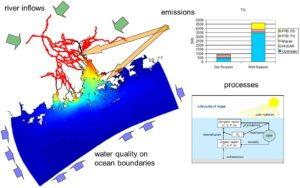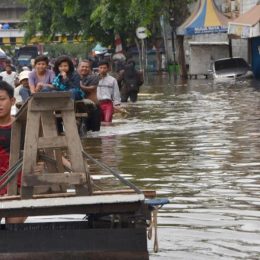Strategy for dealing with eutrophication
Around the world, eutrophication is emerging as a major problem in lakes, rivers and coastal zones near heavily-populated areas. Eutrophication is induced by excess nutrients that enter the water through fertiliser runoffs in agricultural areas, among other things. This leads to a shortage of oxygen in the water (hypoxia) and the ‘bloom’ of algae – some of which produce toxins that are deadly to plants and animals. This in turn affects the local fishing and tourism industries. In response, Deltares has developed a generic strategy for dealing with eutrophication.
Basic elements of the strategy
This strategy for dealing with eutrophication comprises three main elements:
- A conceptual framework for the interaction between water quality, water quantity, soil, groundwater, surface water and climate conditions;
- The ‘from site to sea’ philosophy. This approach examines which effects local measures have on water quality and the ecology in areas located downstream from the site;
- A preferred order for counteractive measures.
![Connectivity of soil, groundwater and surface water during dry, wet, and very wet conditions [Source: Rozemeijer & Broers, 2008]](https://cms.deltares.nl/assets/common/_medium/connectivity-of-soil-groundwater-and-surface-water-Rozemeijer-Broers-2008-768x180.jpg)
Framework for the area analysis process

Deltares supports water managers and government authorities in the implementation of this integrated approach. When they contact us after identifying a problem, we proceed to map out the local ecosystem and how it functions. In this inventory, Deltares examines the interrelation of soil, groundwater, surface water and the key processes that occur at their interfaces. This provides insight into how nutrients move from the site to the sea.
For example, while algal bloom often develops during the summer in stagnant surface water, it is actually caused by nutrients that entered the surface water six months earlier, somewhere upstream. The water managers can use this inventory of causal relationships as a starting point for possible solutions to the problem.
Accurate measurements and models
After completing this system analysis, we clarify which measures are the most cost-effective and sustainable with the aid of measurements and models. In this process, we take the interests of all stakeholders into account: how can you ensure that intensive agriculture remains possible in a given area, without affecting the local fishing industry or tourism? Deltares’ software covers the entire system of water, sediment and solute transport from the site to the sea, allowing modellers to compare the impact of possible measures. The water manager can then decide on the best integrated solution strategy for the area in question.
Optimised order for counteractive measures
Deltares can help water managers and public authorities decide which solutions to pursue – and help them to implement the requisite measures where necessary. To guarantee a future-proof water management programme, it is important to take a long-term view. Simply flushing extra water through the affected area to remove the algal bloom will not solve the problem of eutrophication in the longer term. Ultimately, the goal is to improve the ecosystem as a whole. Based on this integrated vision, Deltares recommends the following optimised order for counteractive measures:
- Ensure that nutrients are optimally used for crop cultivation. This can be achieved via adjustable drainage and precision farming, for example.
- The capture – and re-use, where possible – of nutrient run-offs before they end up in standing surface water. Examples include the use of bio-reactors, decant canals and/or treatment ponds.
- As a final option, the water manager can take countermeasures in those bodies of stagnant surface water that are susceptible to eutrophication. Examples include flushing the water body or covering the nutrient-rich bottom.
Legislation and regulations
Legislation and regulations relating to eutrophication play an important part in safeguarding water quality, both today and in the future. Among other things, Deltares contributes as an independent knowledge partner to the Dutch government’s policy in the areas of fertilisation, the European Water Framework Directive (EWFD) and the European Nitrates Directive (ND). These guidelines have played a major role in the significant improvement of water quality in Europe since the 1990s.
![Optimization of the nutrient reduction strategy for the North Sea (left) [Troost et al., 2014]](https://cms.deltares.nl/assets/common/_small/Figure-3.-Optimization-of-the-nutrient-reduction-strategy-for-the-North-Sea-left-Troost-et-al.-2014-768x543.png)
Publications
-
Nutrient dynamics, transfer and retention along the aquatic continuum from land to ocean: towards integration of ecological and biogeochemical models
-
Monitoring and prediction of phytoplankton dynamics in the North Sea
-
Enhancing generic ecological model for short-term prediction of Southern North Sea algal dynamics with remote sensing images



